ADATA XPG GAMMIX S11 PRO 1TB M.2 NVMe SSD Review
Bohs Hansen / 6 years ago
Introduction
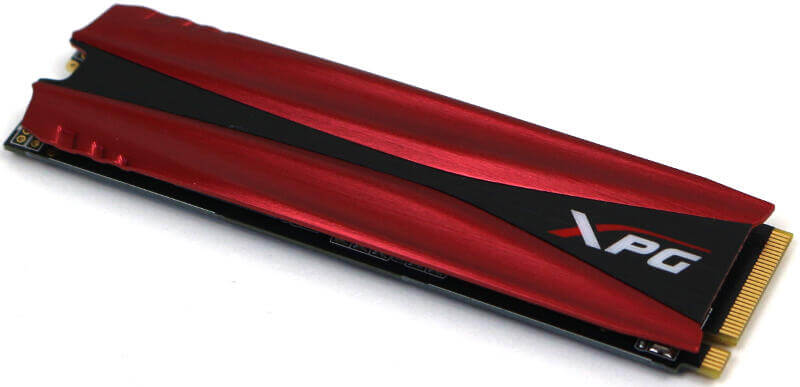
ADATA XPG GAMMIX S11 PRO
I had the pleasure to look at the XPG GAMMIX S11 a while ago and today it’s time to look at the PRO version. The XPG GAMMIX S11 Pro from ADATA takes the drive to the next level with improved performance figures. It’s also available with up to 1TB capacity
XPG GAMMIX S11 PRO
XPG is ADATA’s gaming and high-performance brand and as such, we expect some great things from a drive in that line-up. The new GAMMIX S11 PRO is built on proven components paired with the latest in controller technology. ADATA opted for Silicon Motion’s SM2262EN controller which is a beast. It has eight channels, four ARM Cortex-R5 cores, and plenty of advanced features. The controller is paired with 64-layer 3D TLC NAND for a high-performance drive.
To help boost the performance, the XPG GAMMIX S11 Pro utilises an SLC Cache and a DRAM Cache Buffer. Other features include End-to-End Data Protection, LDPC ECC technology, and RAID Engine. Everything a gamer, PC enthusiast, overclocker, or video rendering professional needs.
As capacity options, we get the most common sizes: 256GB, 512GB, and 1TB.
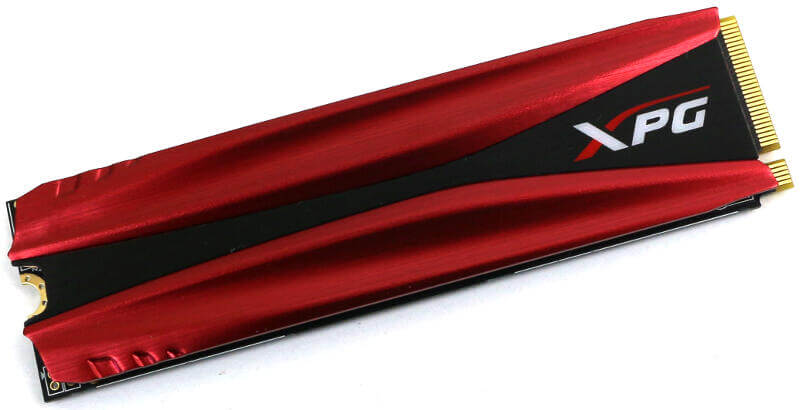
Heatsink, Do We Need This?
Just as with the non-PRO version, the XPG GAMMIX S11 PRO features a heatsink. And do we need it? Well, the short but unclear answer is sometimes. In a perfect setup, it should run flawlessly without. But without, it could run into thermal throttling which no-one wants. The XPG GAMMIX S11 PRO runs 10 degrees cooler with it, making sure that you get the best performance at all times. It also looks really great, especially when compared to a bare module.
There are a few situations where the heatsink isn’t so smart and that is for laptops and motherboards with built-in heatsink solutions. Laptops might not have the free space to support the heatsink. After all, they’re built to be as thin as possible. And motherboards with built-in heatsink solutions for the M.2 slots, well, there it’s obvious. Can’t have it double up.

Drive Performance
Without dragging it out any longer, let us get to performance figures. The drive supports NVMe 1.3 and it is a PCIe Gen3 x4 drive. As such, it’s capable of big things. The sequential performance is rated at up to 3500MB/s when reading and 3000MB/s when writing. That’s a big step up in the write speed from the non-PRO model. The random performance increased as well, but not as much as the sequential. The GAMMIX PRO delivers up to 390K read and 380K write 4K random IOPS.
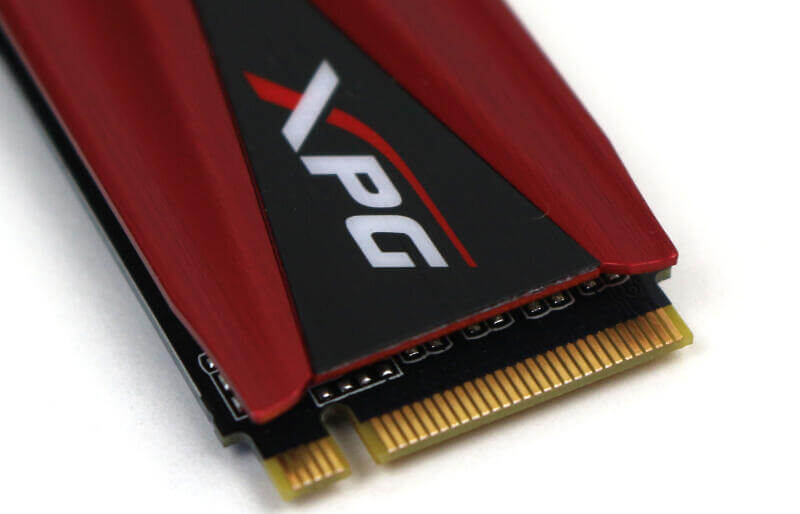
Endurance and Warranty
Performance is important, but so is endurance. ADATA backs the XPG GAMMIX S11 PRO with a really nice 5-year warranty. The drive is rated for an MTBF of 2 million hours while the TBW rating comes in at 160TB, 320TB, and 640TB for the 256GB, 512GB, and 1TB drives respectively.

What Does ADATA Have to Say About the Drive?
Implementing advanced 3D NAND Flash, XPG GAMMIX S11 Pro SSDs features higher storage capacities ranging from 256BG to 1TB, while also providing higher efficiency, rugged reliability and a high TBW (Total Bytes Written).
Employing the extra-fast PCIe Gen3x4 interface and featuring NVMe 1.3 support, intelligent SLC Caching, and a DRAM cache buffer, the SSDs accelerate read/write speeds up to 3500/3000MB/s and deliver random performance of up to 390K/380K IOPS.
Whether booting, gaming or transferring large files, S11 Pro SSDs accomplish them quickly and effectively. The SSDs also support LDPC (Low-Density Parity-Check) error correcting code technology to detect and fix a wider range of data errors for more accurate data transfers.
Meanwhile, End-to-End Data Protection and RAID Engine support ensure data security and improve transmission stability. What’s more, a heatsink with a sports-car-inspired design on the outside make S11 Pro SSDs look and stay cool. Compared to M.2 SSDs without a heatsink, an S11 Pro SSD is up to 10°C cooler, offering enhanced system stability.
https://www.youtube.com/watch?v=W1l5ja42I0k
Feature Highlights
- PCIe 3×4 and NVMe 1.3 Supported
- Up to 3500MB/s and 390K IOPS performance
- Great looking heatsink for up to 10° lower temperatures
- LDPC, End-to-End data protection, RAID engine
- Standard 2280 Form Factor
- 5-Year Warranty
Package and Accessories
The packaging is quite standard for an SSD. We get a cardboard box with a hard plastic insert. The box itself is made up of the same colours as the drive, black and red with a little white. The feature highlights and capacity are all shown on the front from where you can see the included drive as well.
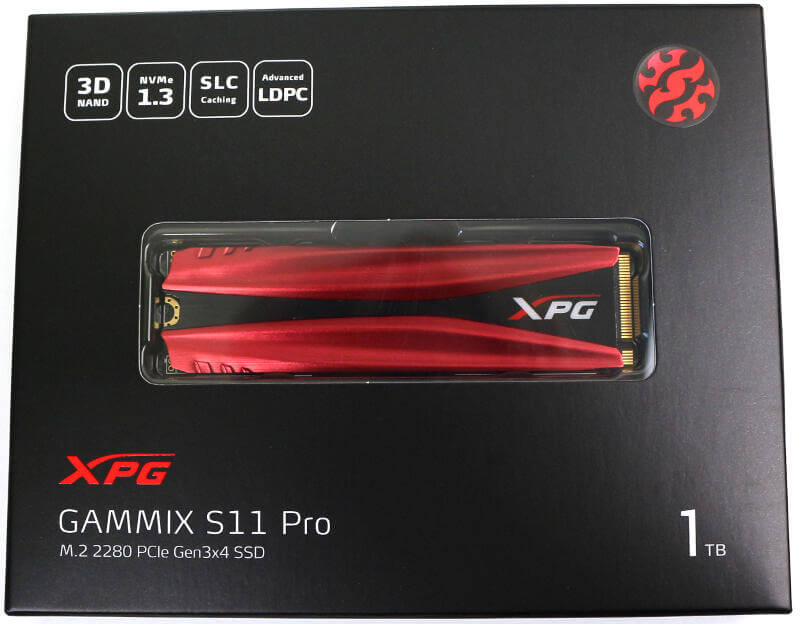
The rear side has a few more details in various languages. It also features a QR code which you can scan for a quick linking to the product page.
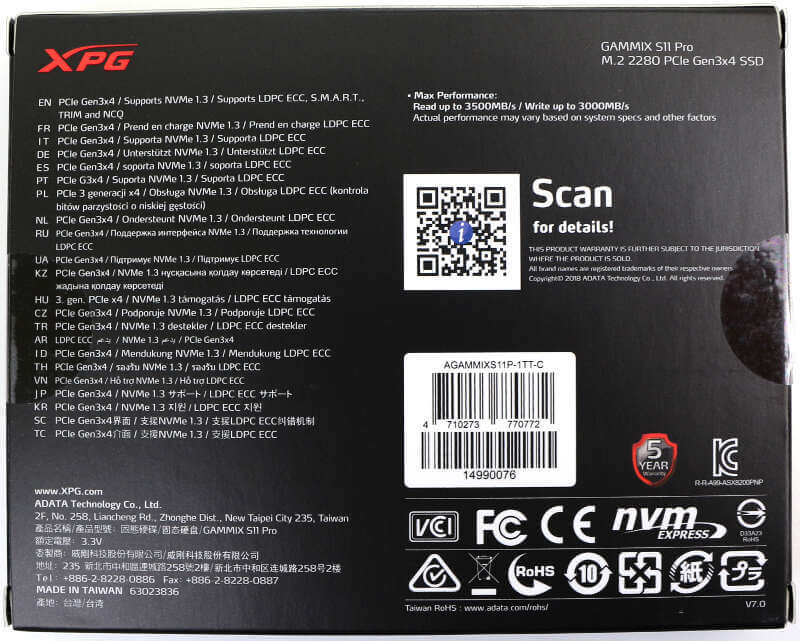
Testing & Methodology
In a bid to make our testing as thorough and as accurate as possible, we have devised a testing methodology that will give us the maximum amount of data. While this means that testing each drive will take considerably longer – easily up 36 hours – the overall picture that we can gather is bigger too. It helps both you as the reader and us as the reviewer’s to gain a clearer view of the drive’s overall performance, strengths, and weaknesses. It also provides a more accurate analysis of how each drive performs under different conditions.
Data Fillage
There are many ways to test a storage drive, and we have chosen to include close to every test possible. We will start with a typical benchmark analysis of the formatted drive with various village scenarios. However, depending on how a drive is built, the performance may differ depending on how much data it is already storing. Testing this, the drive will be tested empty as well as with 25%, 50%, and 75% space usage. For these tests, we will be using Anvil’s Storage Utilities, AS SSD Benchmark, ATTO Benchmark, and CrystalDiskMark.
Application and Gaming
Besides these synthetic fill tests, the drive is tested with PCMark 8’s storage benchmark to get real-world performance results.
Plain Drive Performance
Following the fillage tests, the partition gets removed, and we check the drive’s raw performance. These tests will determine the hardware’s capabilities while eliminating any interference from the set file system. AIDA64’s storage benchmark and IOmeter are both great tools for this, and they help us paint an even clearer picture of the drive. The IOmeter tests I run are quite different from the rest as they will give a final result after a longer performance test rather than a maximum or average score; this gives us yet another view of the tested drive over the regular tests.
Drive Conditioning
Durability is a vital factor when it comes to NAND-based drives as the chips only can be rewritten so many times before they’ll stop working properly. Modern SSDs come with wear-level algorithms to increase the lifetime and reduce this factor as much as possible. We also take this into consideration in our reviews even tho it would take years to simulate this under real-world conditions. Luckily, Anvil’s Storage Utilities comes with an endurance test that can perform this action much faster, but it is still a time-consuming process. Depending on the hardware, this can easily take several days, and we write thousands and thousands of small files in various sizes and compressibility to drive over and over.
Following this conditioning process, all of the previous benchmarks will be run again in the same scenarios and the same order. This will give us a great view of how a drive will perform after prolonged usage, and that is a very vital factor when you pick out your storage drive.
The Preparation and In Between
The drive will be formatted as NTFS with default settings, as most users will do. The quick format option isn’t used as that might affect the performance the first time data is written.
Modern operating systems all take care of the TRIM command in the background and it isn’t something to worry about for regular users. However, for these reviews, I will add a waiting period between each benchmark to make sure that the TRIM command has been fully executed and finished. After all, we want a clear picture of the drive’s performance with minimal interference from the operating system.
On each page that follows with the benchmark results, I have inserted result screenshots from the benchmarks, created drive analysis chart for the fill-level performance, and added drive comparison charts where possible.
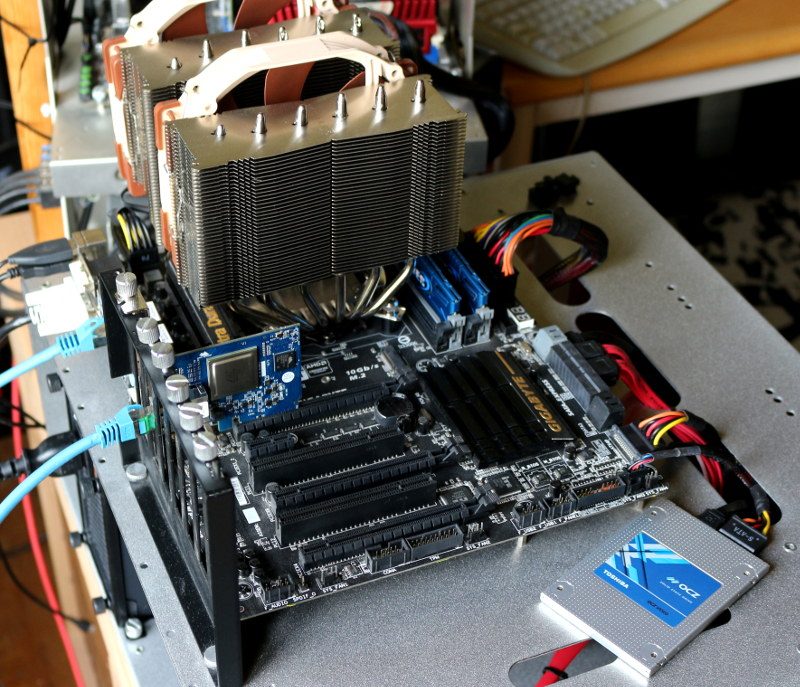
Hardware
- Supermicro C7Z270-PG
- Intel Core i7-7700K
- Crucial Ballistix Sport DDR4 2400MHz (4x8GB)
- Toshiba OCZ VX500 512GB SSD
- be quiet! Dark Power Pro 11 (1200W)
- Noctua NH-D15S
- Cooler Master HAF XB EVO with Noctua NF-A14 FLX fans
Software
- AIDA64 Storage Benchmark
- Anvil’s Storage Utilities
- AS SSD Benchmark
- ATTO Benchmark
- CrystalDiskMark
- IOMeter
- PCMark 8 Storage Benchmark
- Windows 10
AIDA64
AIDA64 is a streamlined Windows diagnostic and benchmarking software for home users with a broad range of features to assist in overclocking, hardware error diagnosis, stress testing, and sensor monitoring.
The app has unique capabilities to assess the performance of the processor, system memory, and disk drives and is compatible with most Microsoft Windows operating systems. It also has a disk benchmark tool, and that is the one I’ll be using.
Fresh Drive
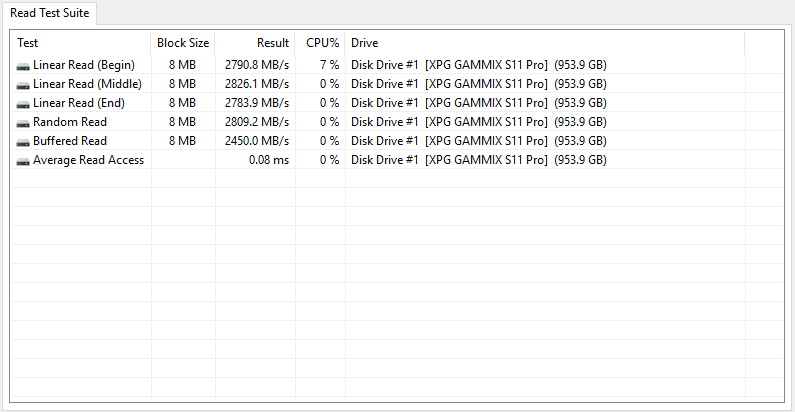
The Linear Read and Write tests measure the sequential performance by reading or writing all sectors without skipping any. It gives us a view of the drives overall performance from start to end.
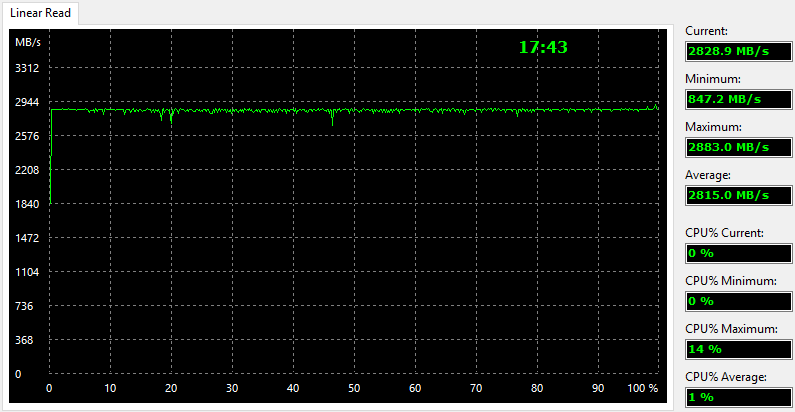
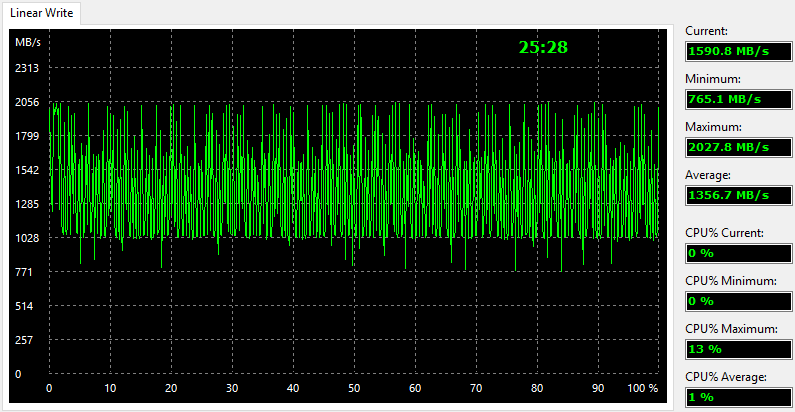
The Random Read and Write tests measure the random performance by reading or writing variable-sized data blocks at random locations on the surface of the drive. The Random tests are a combination of both speed and access times as it moves the position before each new operation.
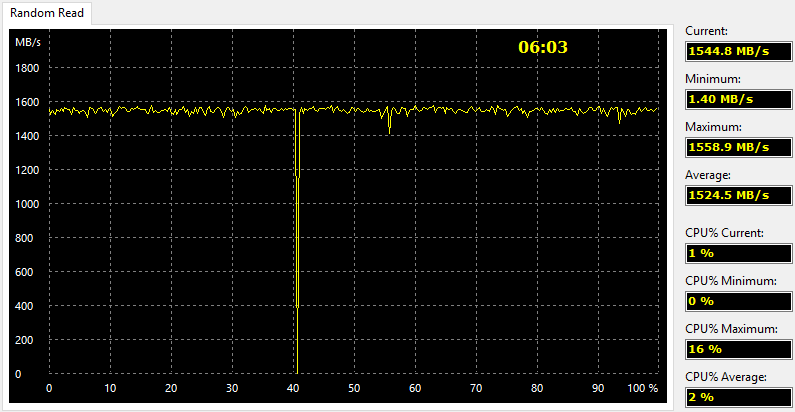
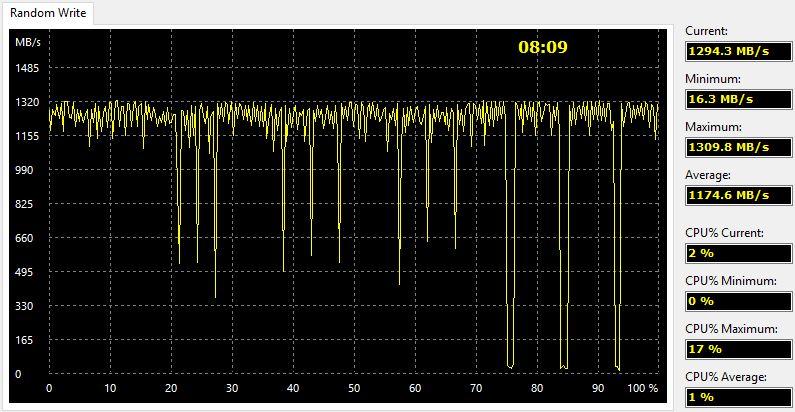
The Access time tests are designed to measure the data access performance by reading or writing small 0.5KB data blocks at random locations on the drive surface.
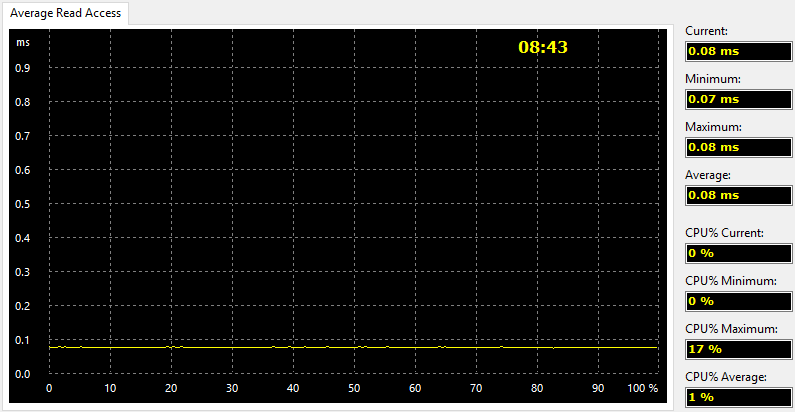
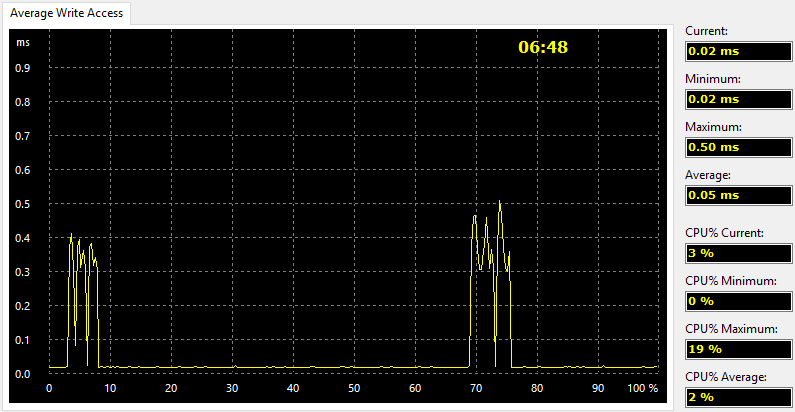
Conditioned Drive
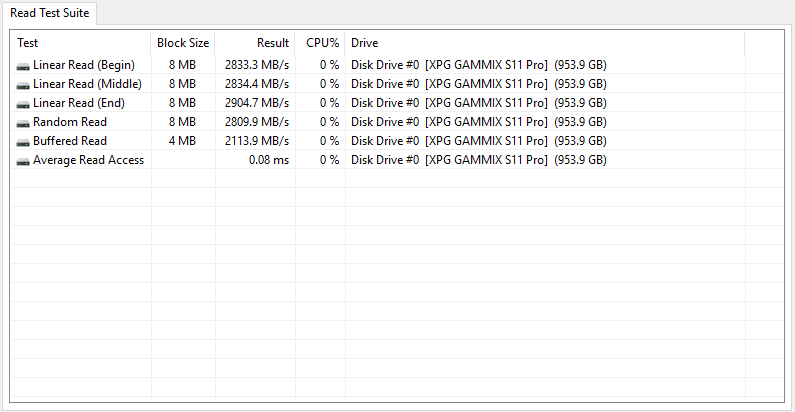
The Linear Read and Write tests measure the sequential performance by reading or writing all sectors without skipping any. It gives us a view of the drives overall performance from start to end.
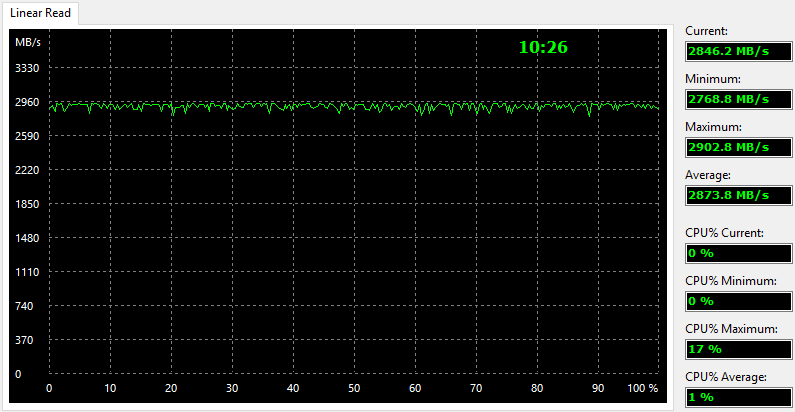
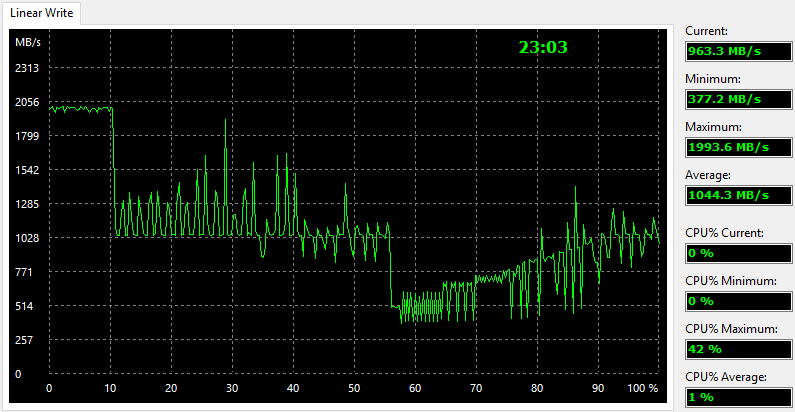
The Random Read and Write tests measure the random performance by reading or writing variable-sized data blocks at random locations on the surface of the drive. The Random tests are a combination of both speed and access times as it moves the position before each new operation.
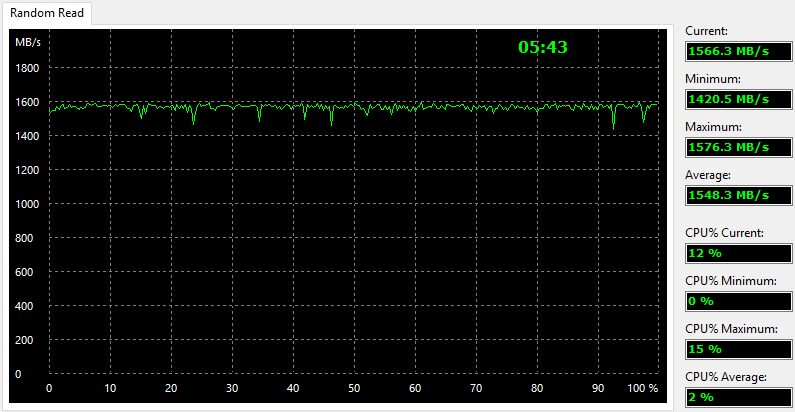
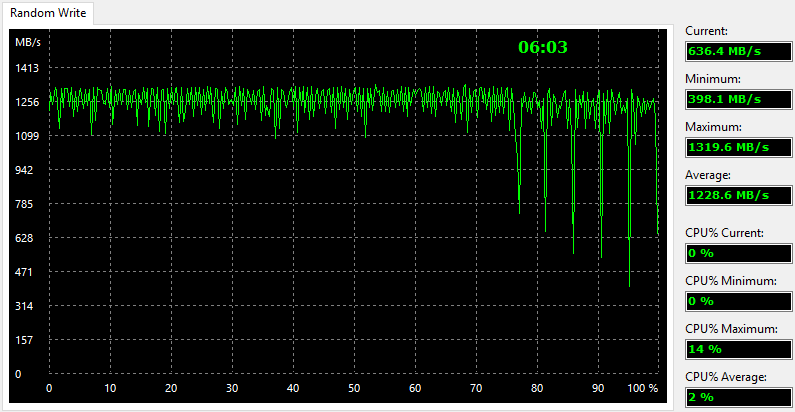
The Access time tests are designed to measure the data access performance by reading or writing small 0.5KB data blocks at random locations on the drive surface.
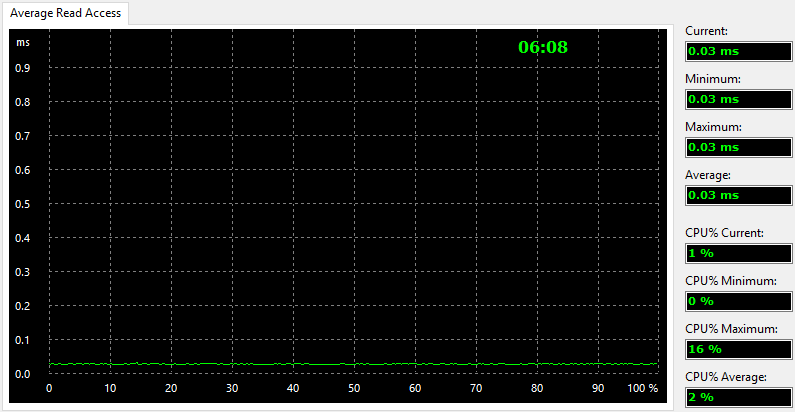
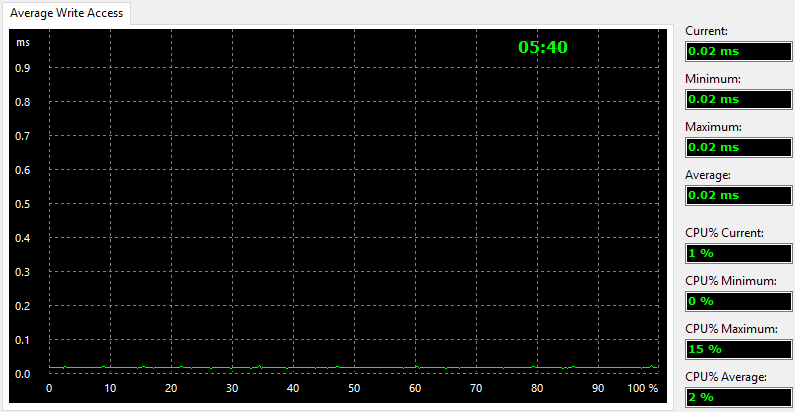
Drive Performance Analysis
With the performance analysis, we get a good view of the drive’s consistency. The straight line and a higher average performance are the things to look for here.
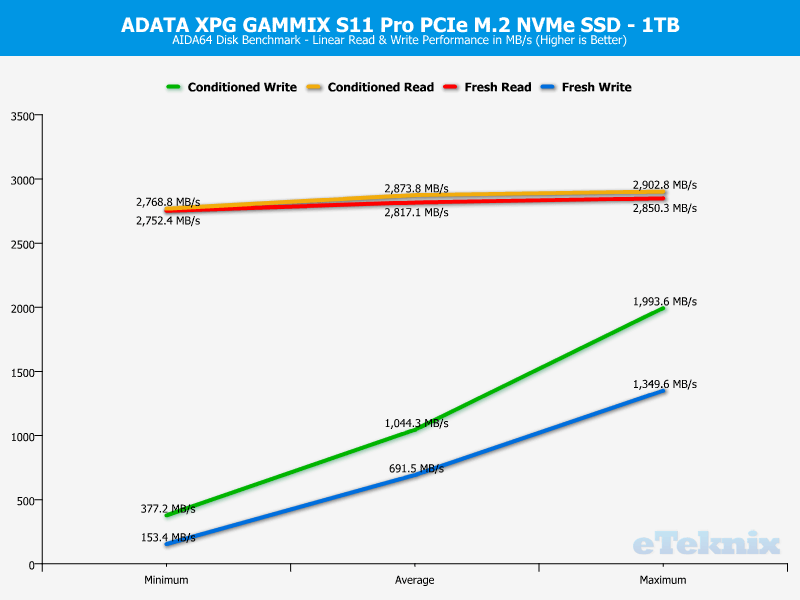
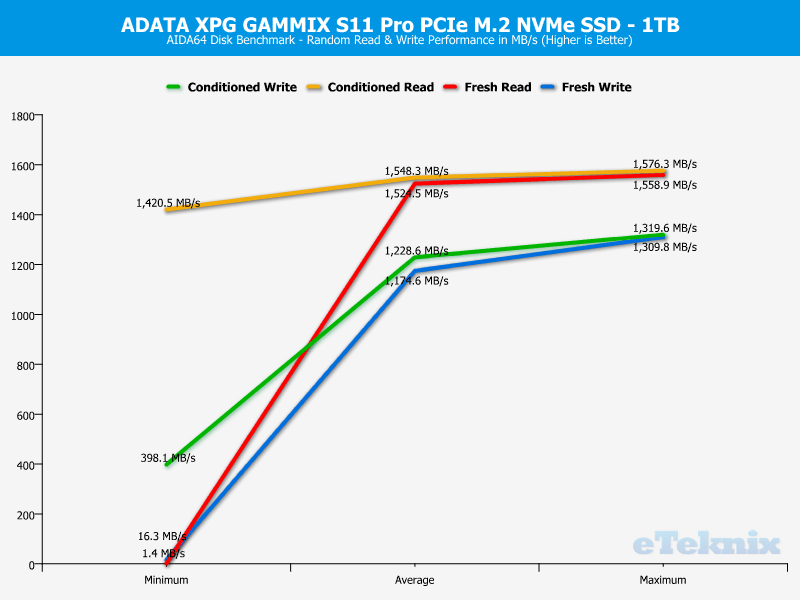
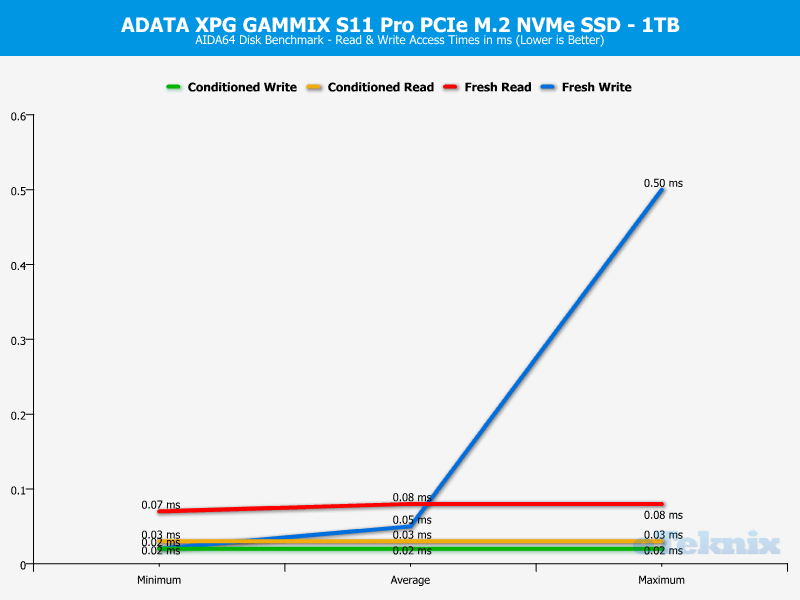
Anvil’s Storage Utilities
Anvil’s Storage Utilities is a complete benchmark solution used to test any writeable storage drive. It also has a drive endurance test that consistently reads and writes data to the selected medium to deliver days, months, and potentially even years of use in a shorter period.
Fresh Drive
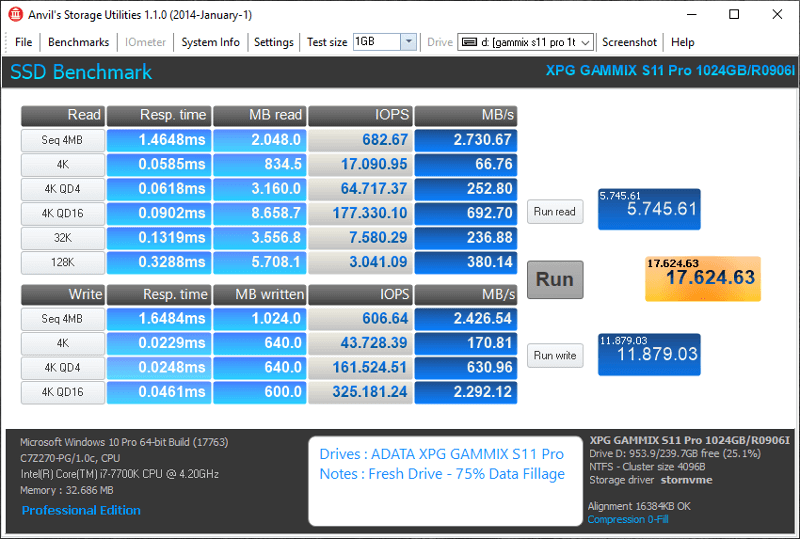
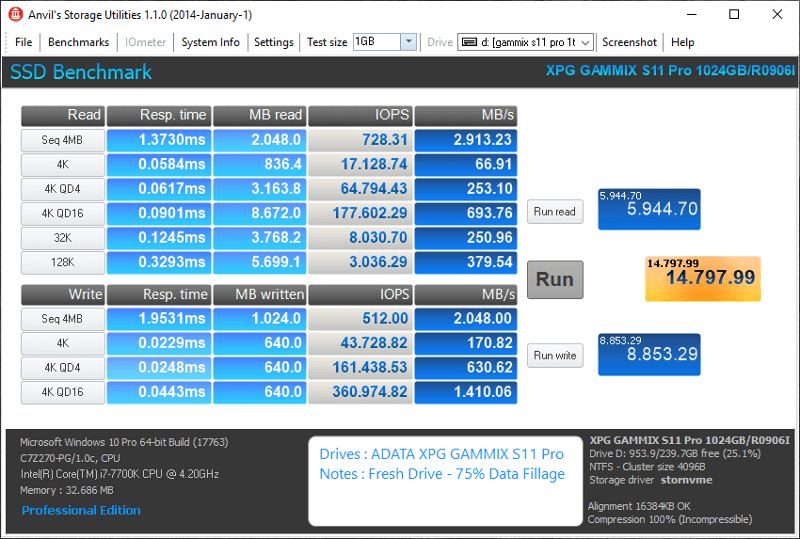
Conditioned Drive
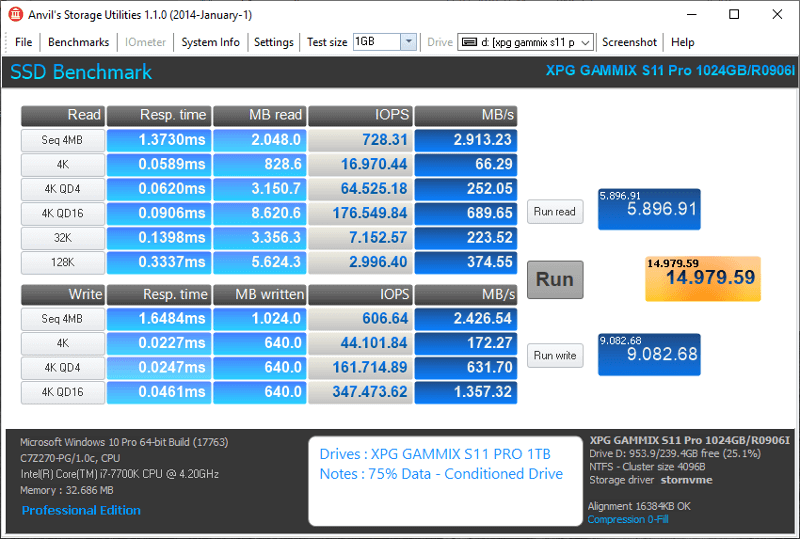
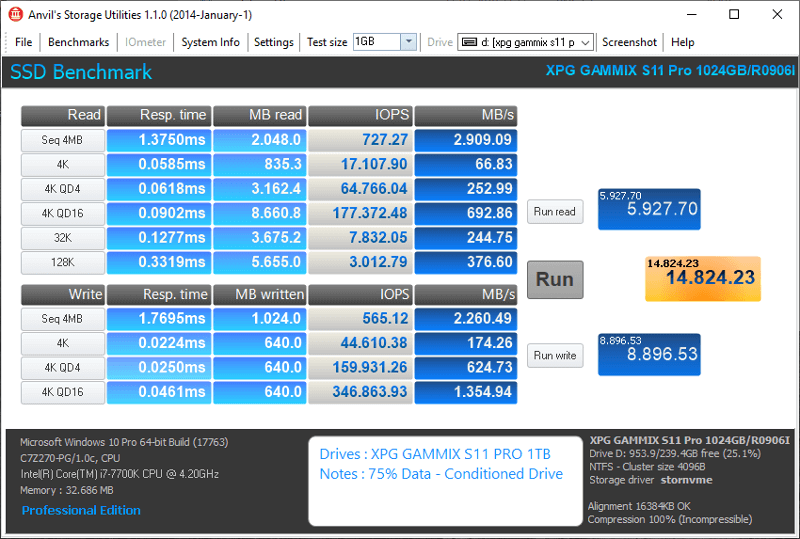
Drive Performance Analysis
With the performance analysis, we get a good view of the drive’s consistency. We want as straight a line as possible for a good result.
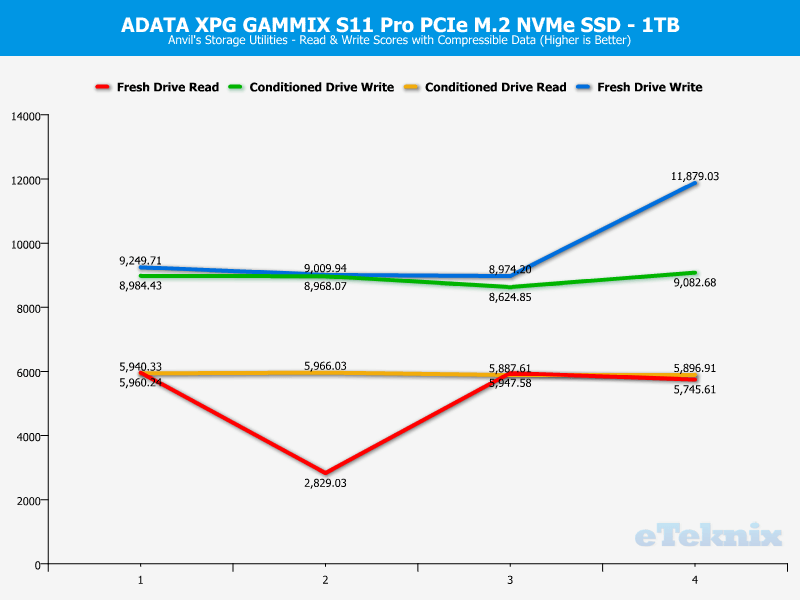
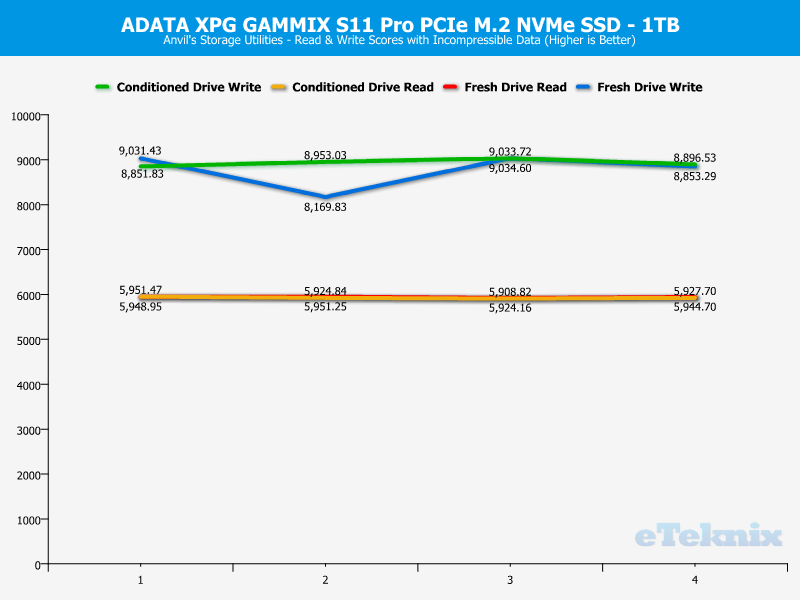
Drive Comparison
For the drive comparison, we will use the performance figures from empty drives here.
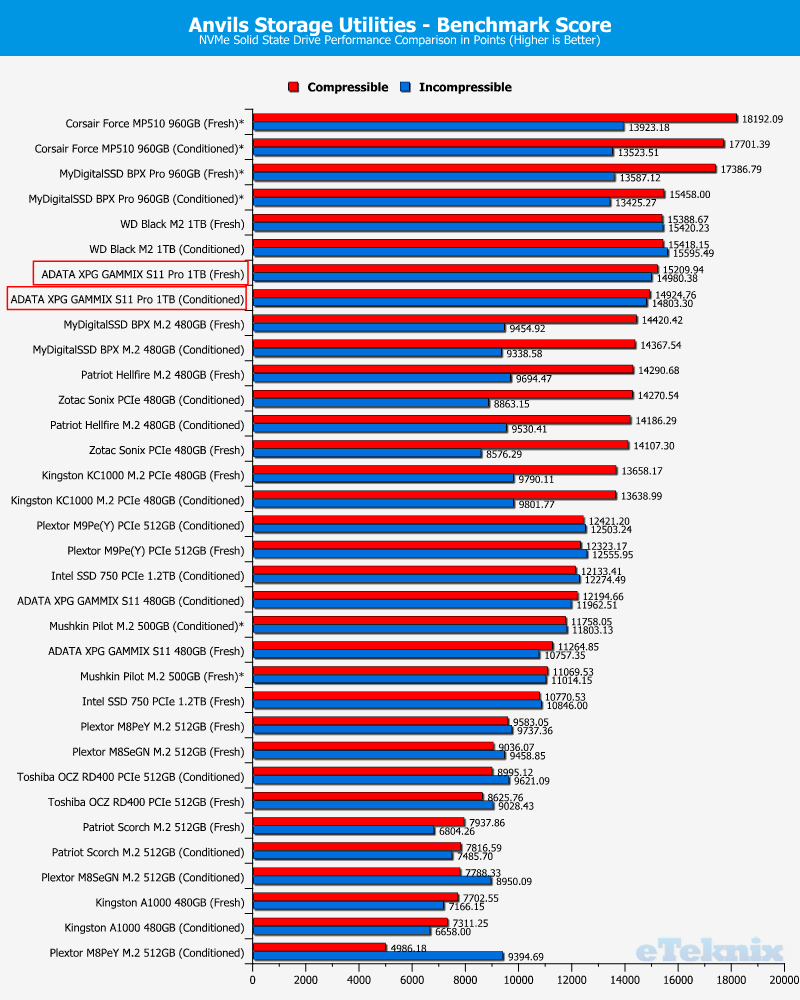
AS SSD Benchmark
The AS SSD software determines the performance of Solid State Drives (SSD). The tool contains five synthetic and three practice tests. The synthetic tests determine the sequential and random read and write performance of the SSD, and they aren’t using the operating system cache. The copy tests are cached and as such not viable results at this time.
Fresh Drive
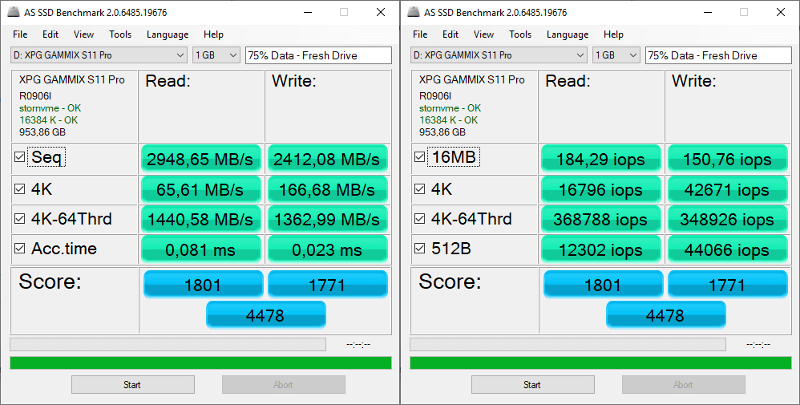
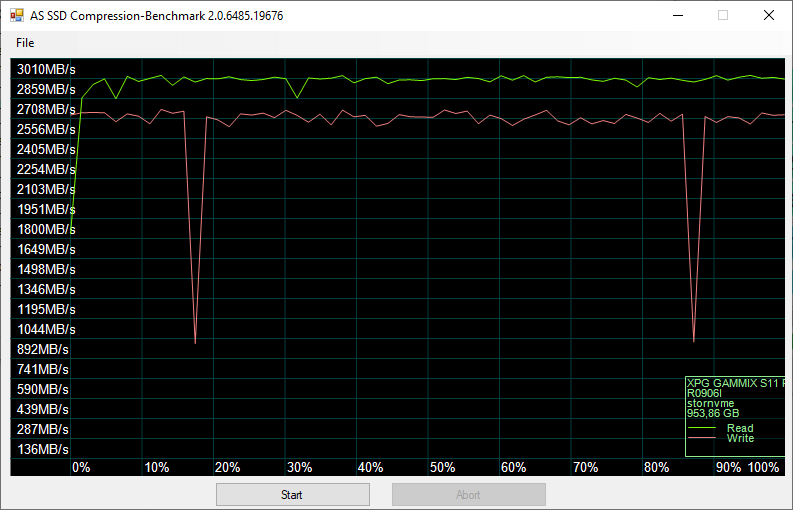
Conditioned
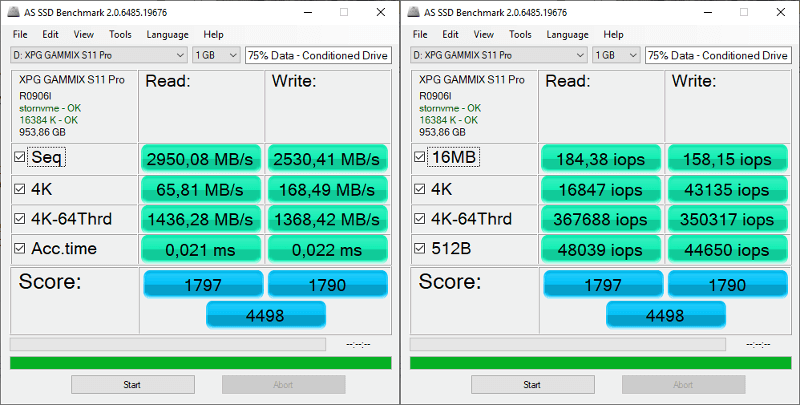
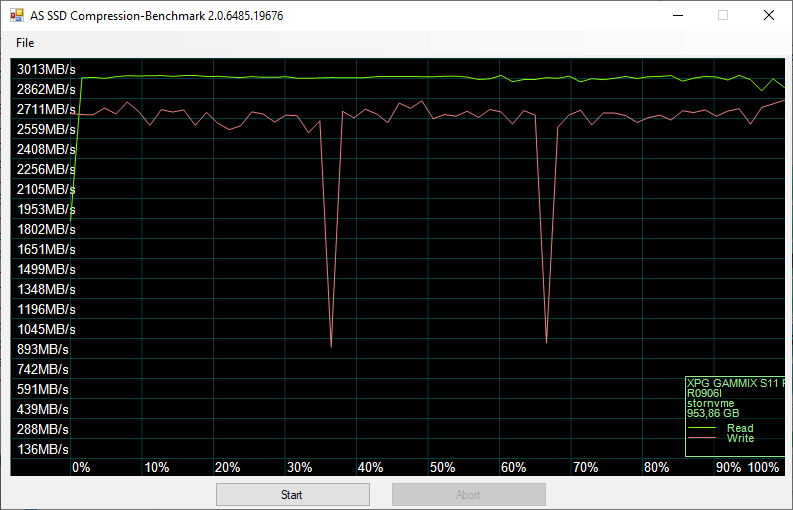
Drive Performance Analysis
With the performance analysis, we get a good view of the drive’s consistency. We want as straight a line as possible for a good result.
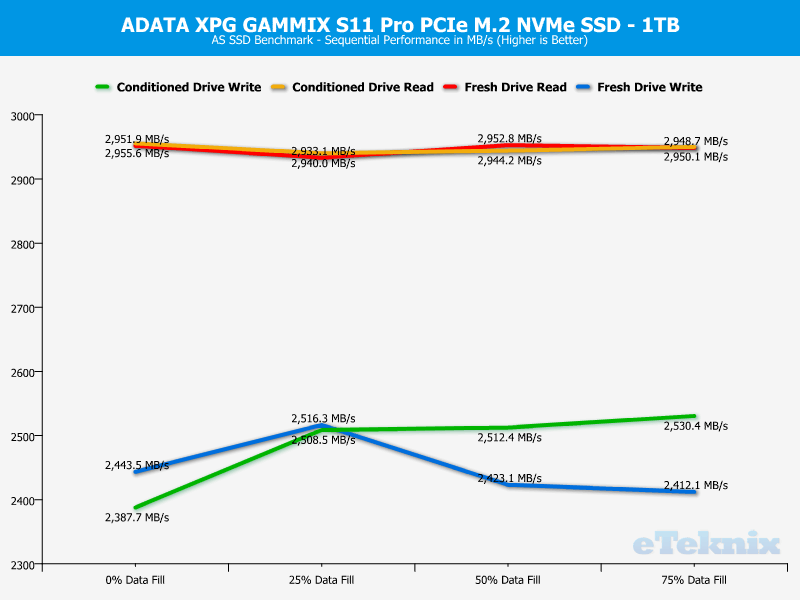
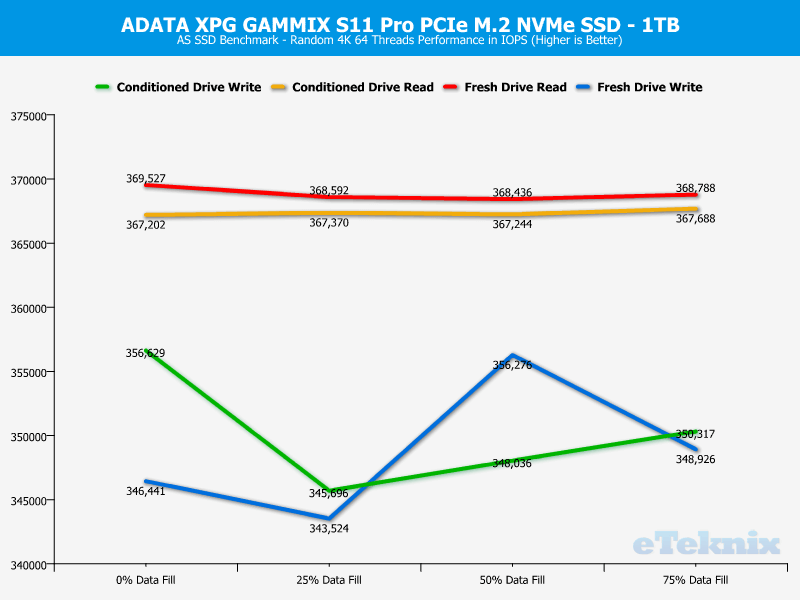
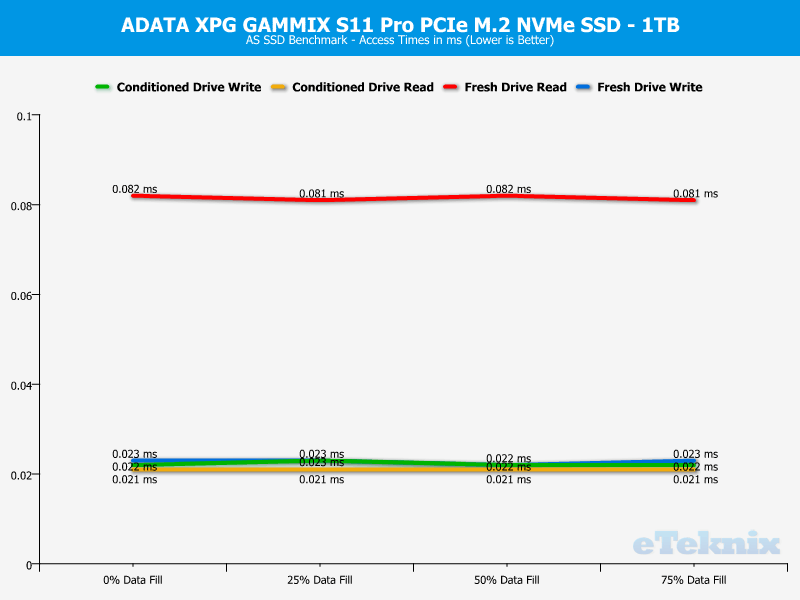
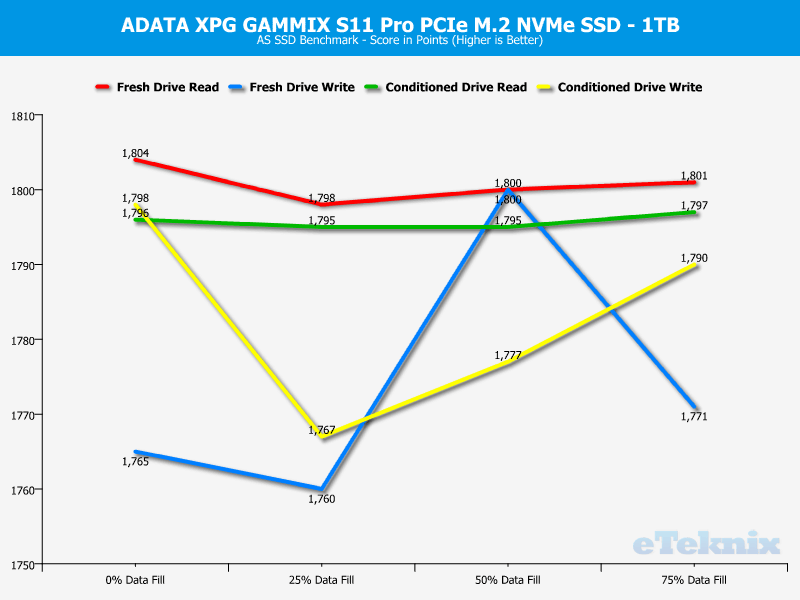
Drive Comparison
For the drive comparison, we will use the performance figures from empty drives here.
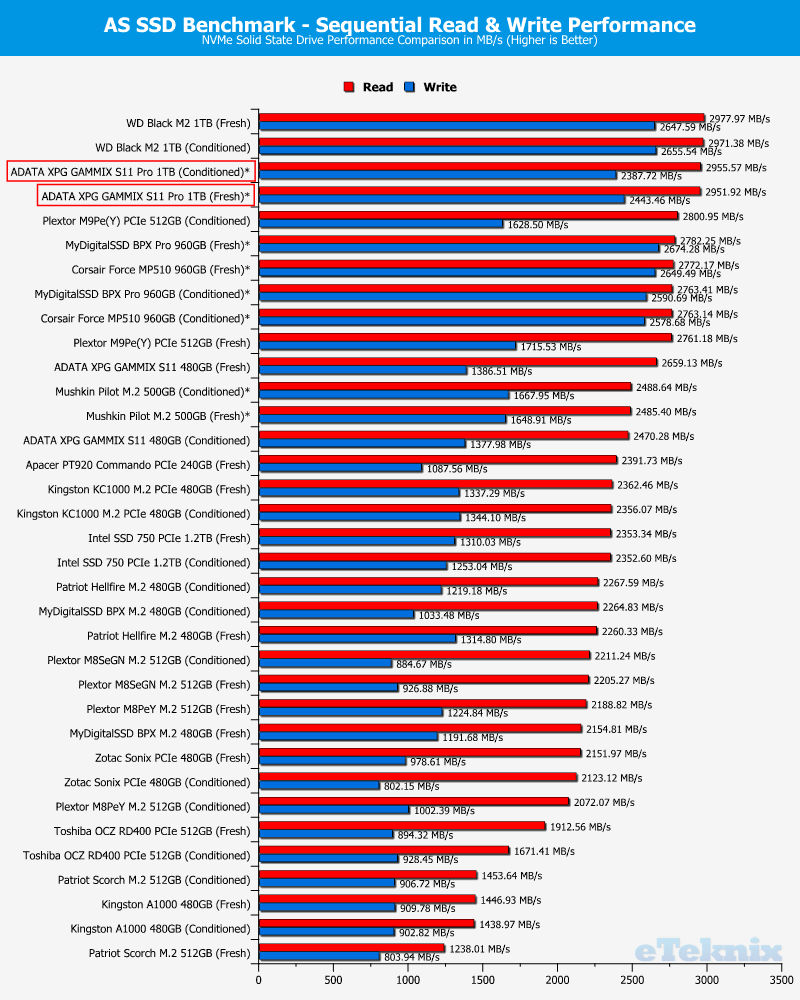
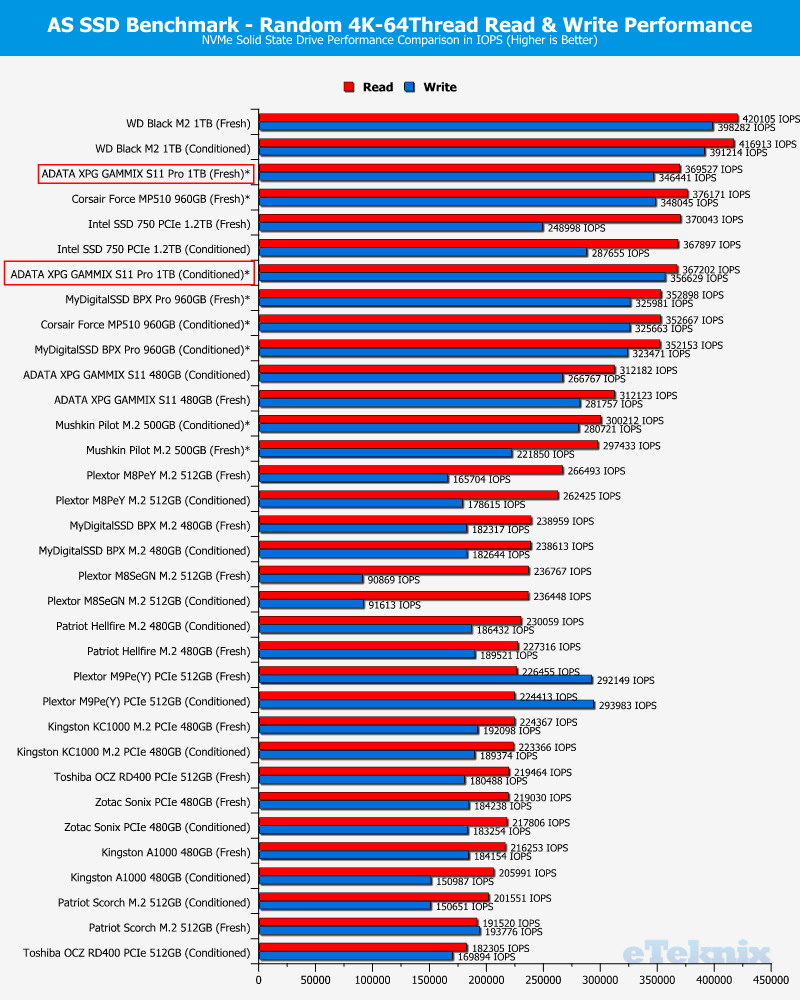
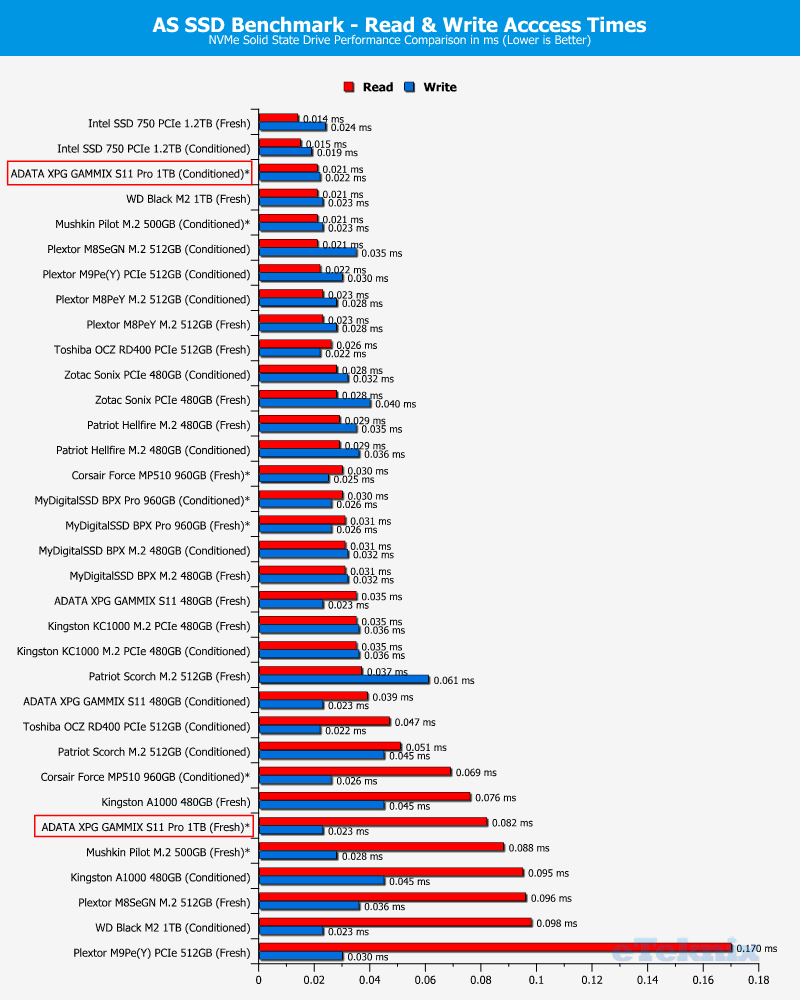
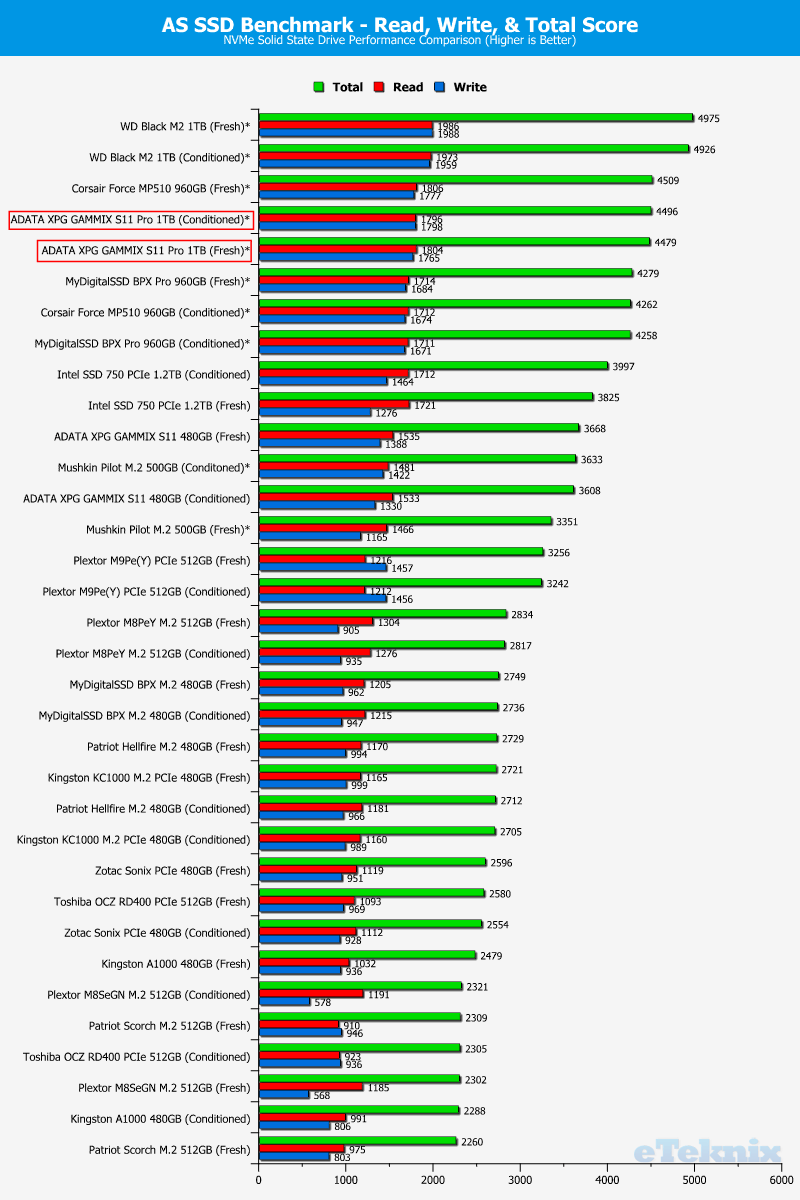
ATTO
The ATTO Disk Benchmark performance measurement tool is compatible with Microsoft Windows. Measure your storage systems performance with various transfer sizes and test lengths for reads and writes. Several options are available to customise your performance measurement including queue depth, overlapped I/O and even a comparison mode with the option to run continuously.
Fresh Drive
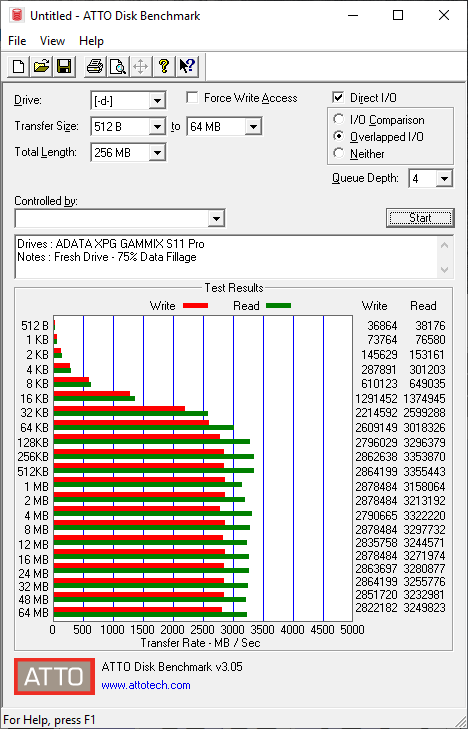
Conditioned
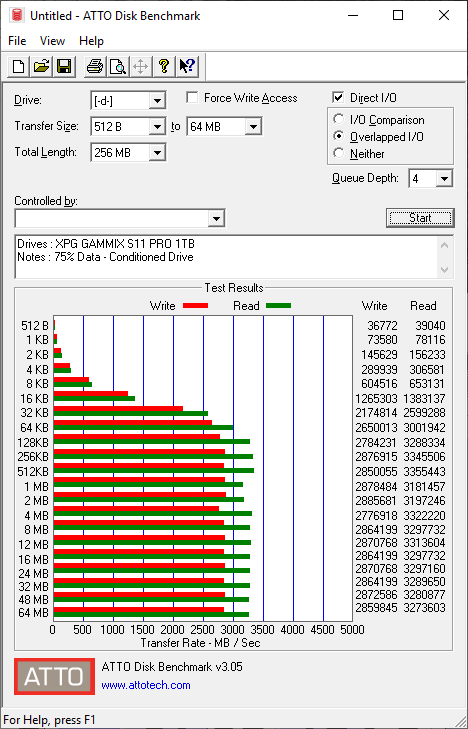
Drive Performance Analysis
With the performance analysis, we get a good view of the drive’s consistency. We want as straight a line as possible for a good result.
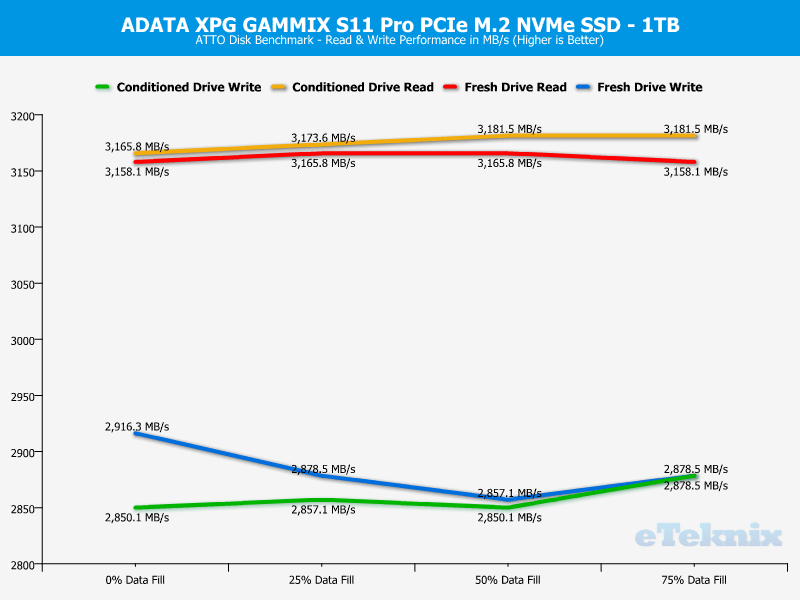
Drive Comparison
For the drive comparison, we will use the performance figures from empty drives here.
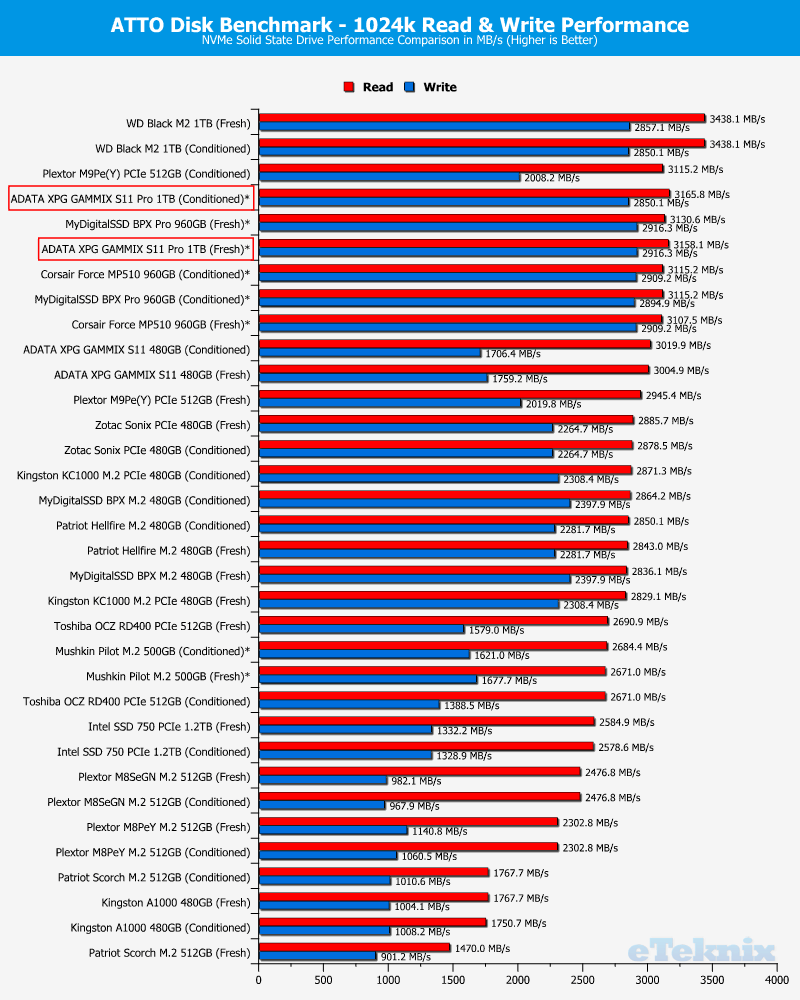
CrystalDiskMark
CrystalDiskMark is a small HDD and SSD benchmark utility that allows you to measure a drive’s sequential and random performance.
Fresh Drive
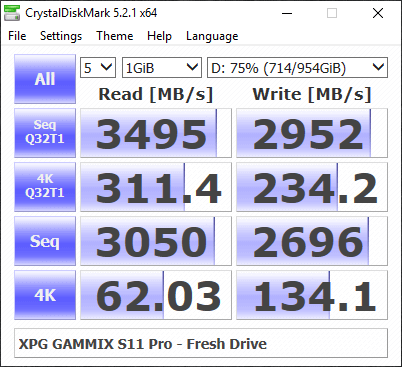
Conditioned
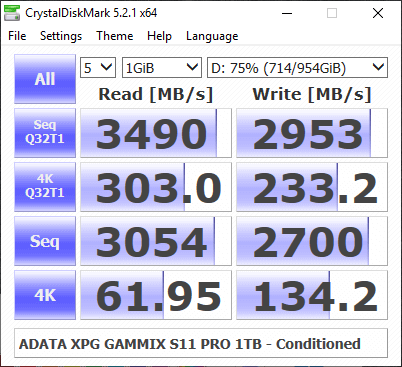
Drive Performance Analysis
With the performance analysis, we get a good view of the drive’s consistency. We want as straight a line as possible for a good result.
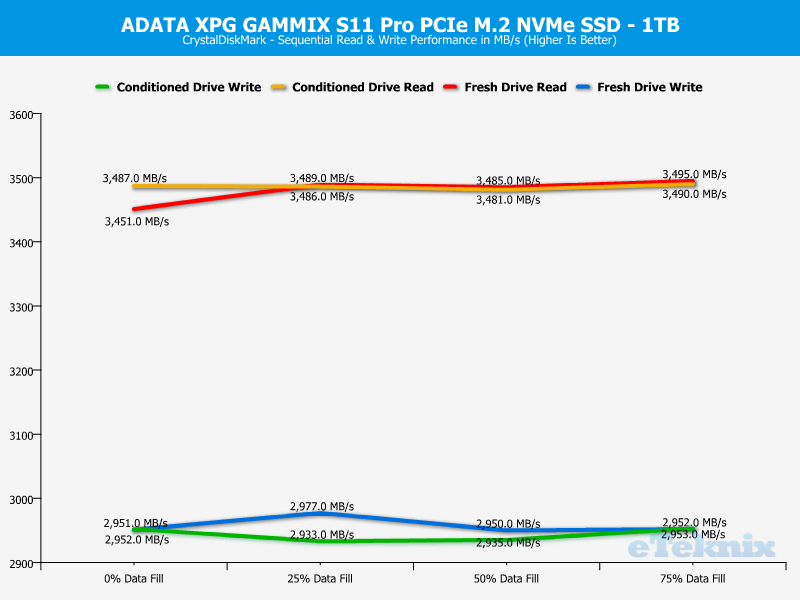
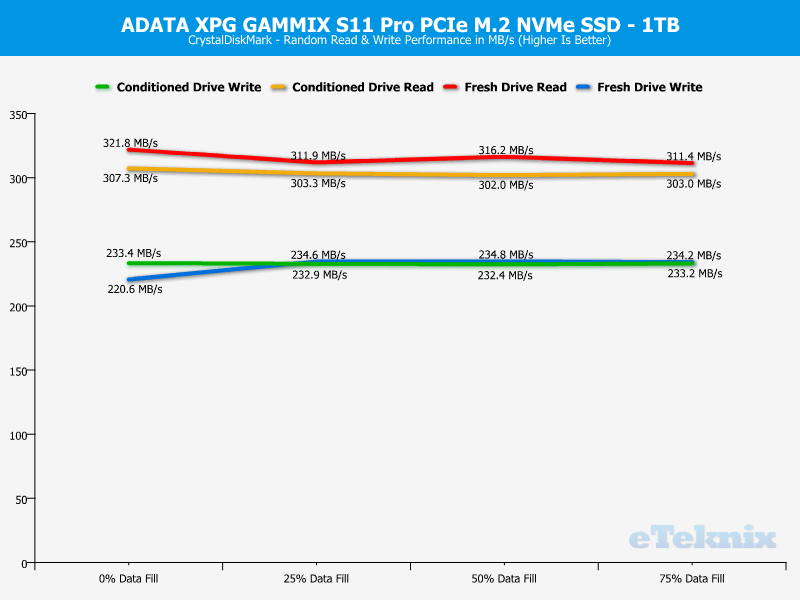
Drive Comparison
For the drive comparison, we will use the performance figures from empty drives here.
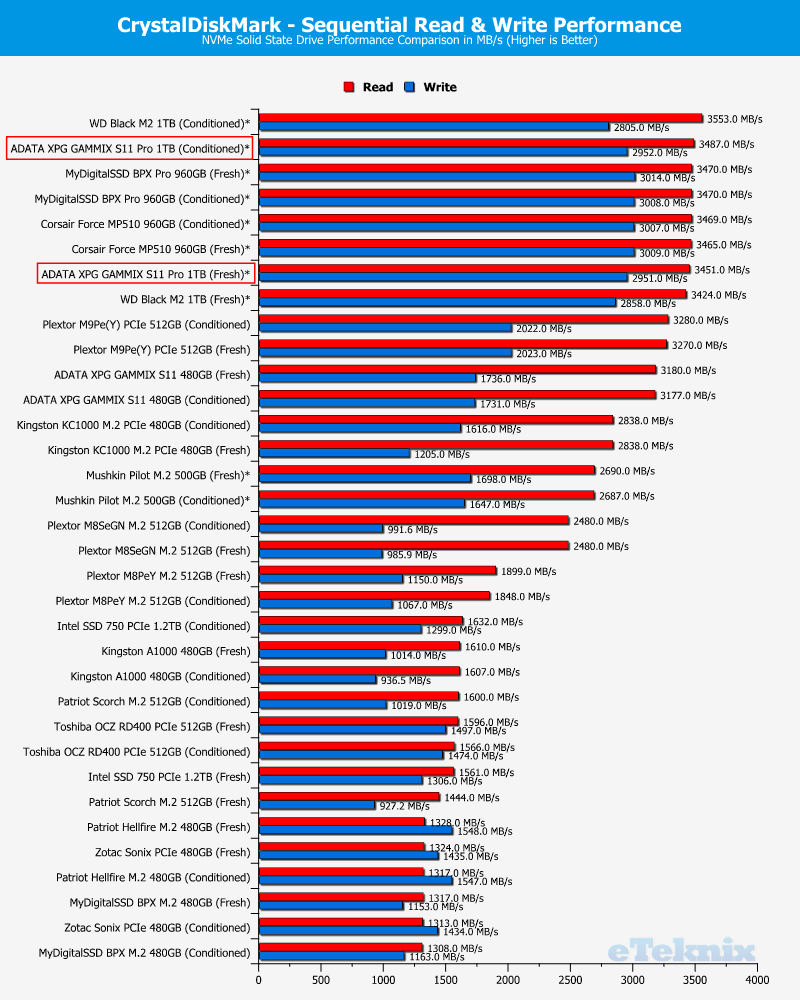
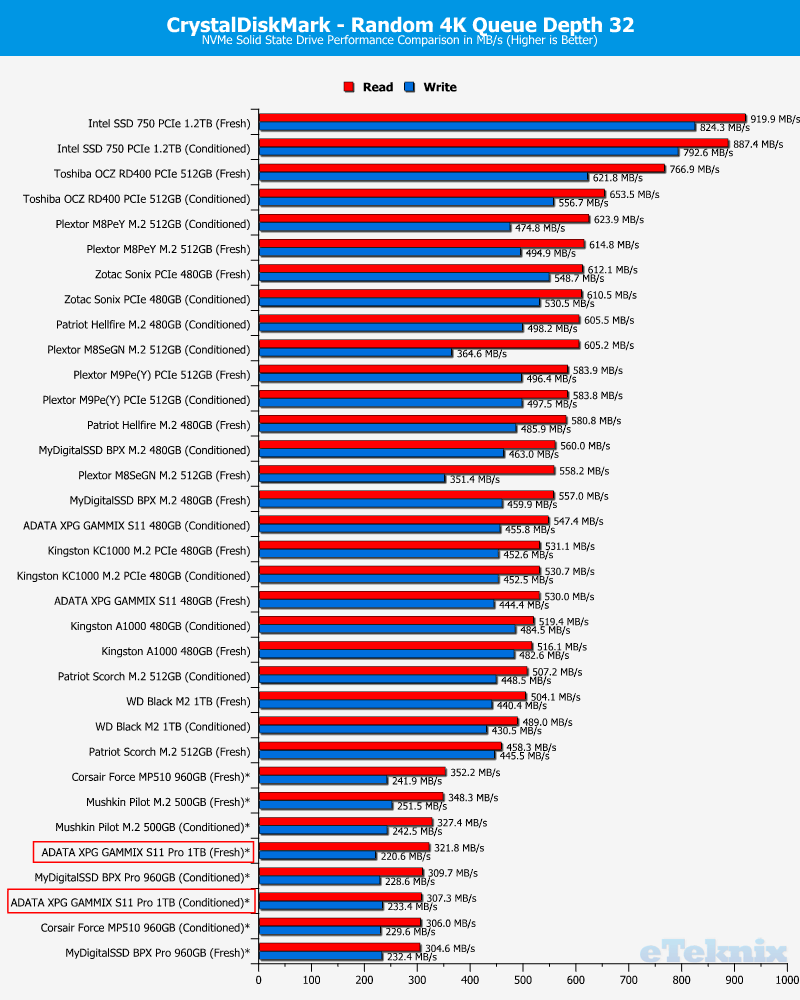
IOMeter
IOMeter is an I/O subsystem measurement and characterisation tool for single and clustered systems. As a benchmark and troubleshooting tool, it is configurable to replicate the behaviour of many popular applications. One commonly quoted measurement provided by the tool is IOPS.
Sequential Performance
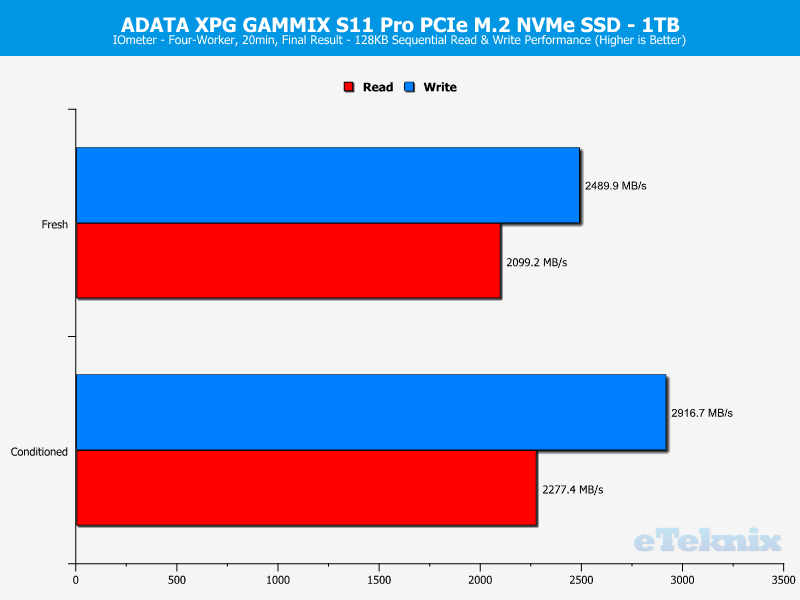
Random 4K Performance
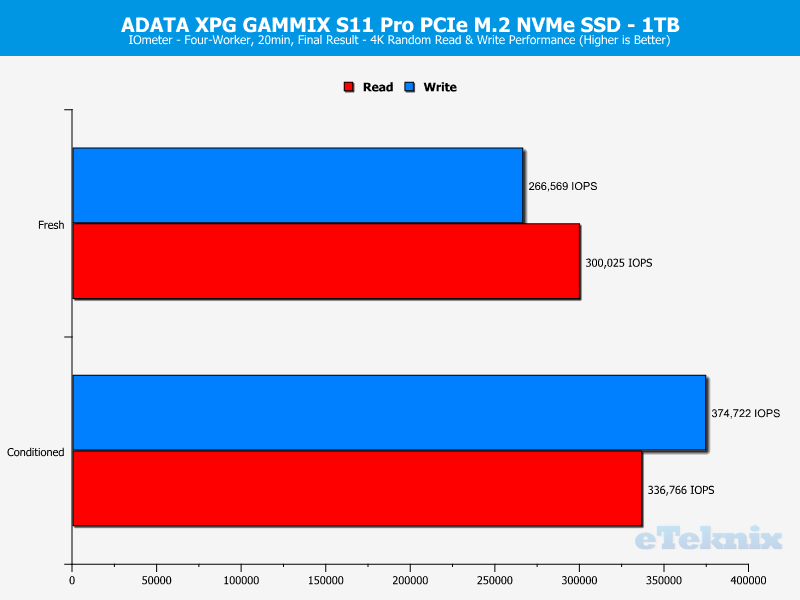
Drive Comparison
IOmeter is run on an unpartitioned drive.
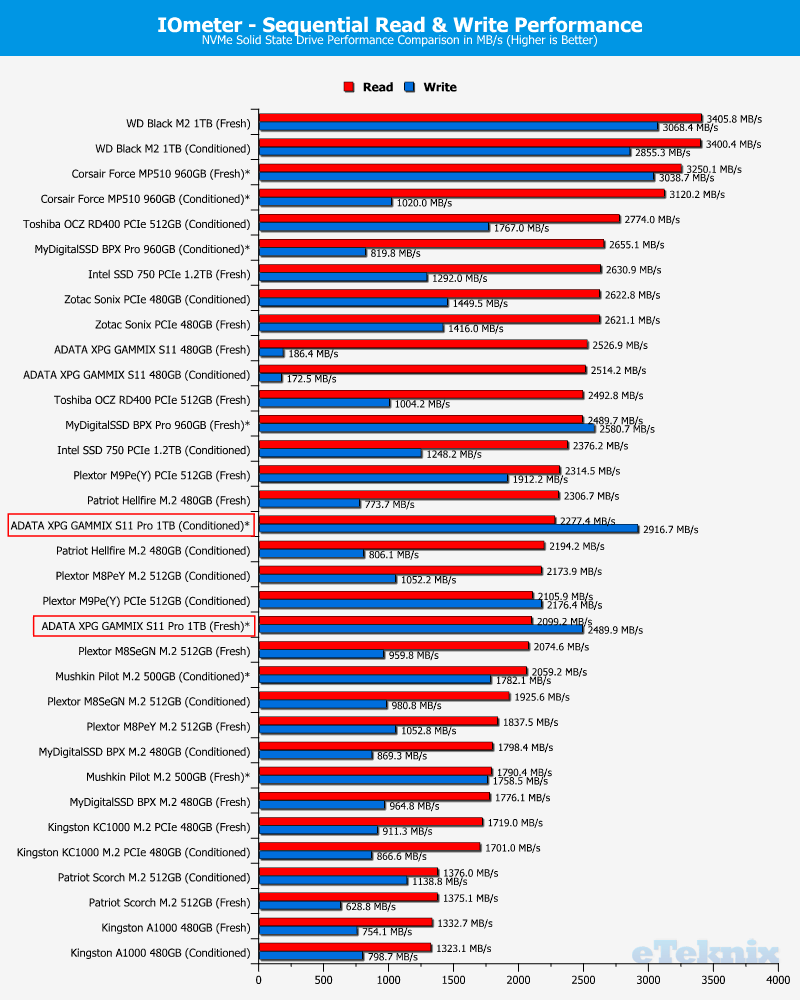
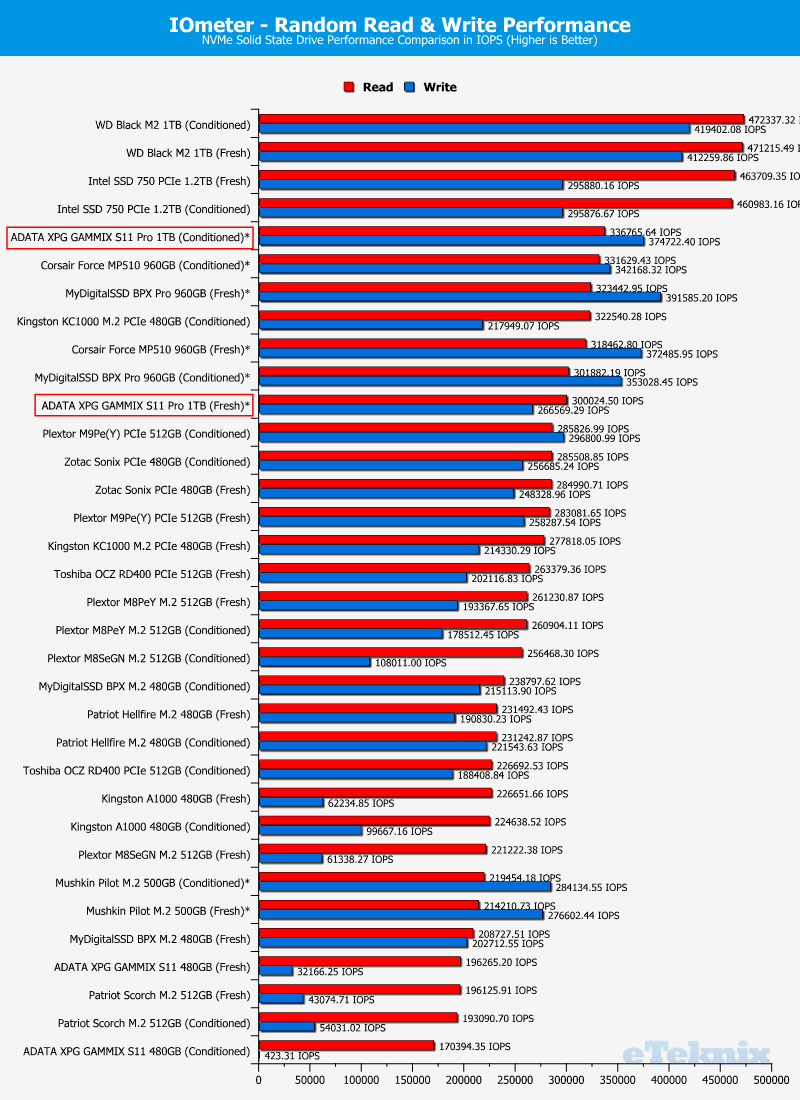
PCMark 8 Storage Benchmark
PCMark 8 Storage benchmark tests the performance of SSDs, HDDs, and SSHD hybrid drives with traces recorded from Adobe Creative Suite, Microsoft Office and a selection of games. You can test any recognised storage device, including local external drives. Unlike synthetic storage tests, the PCMark 8 Storage benchmark highlights real-world performance differences between storage devices.
Fresh Drive
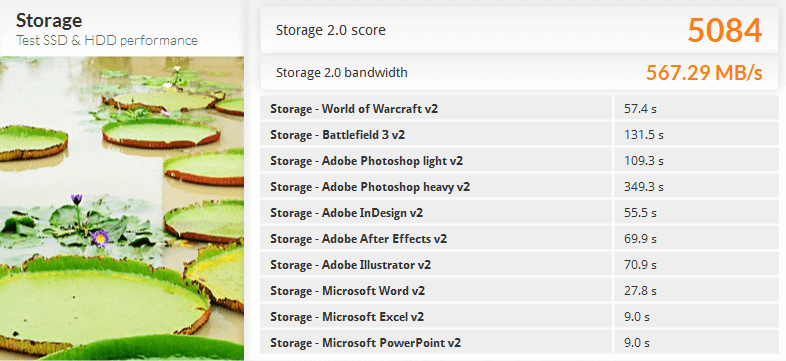
Conditioned Drive
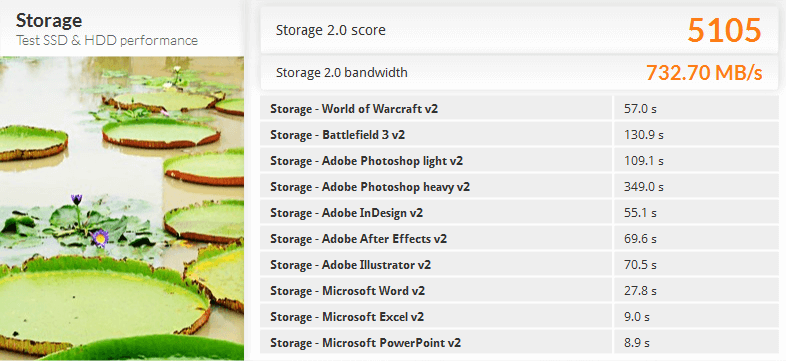
Drive Comparison
For the drive comparison, PCMark runs with an empty drive.
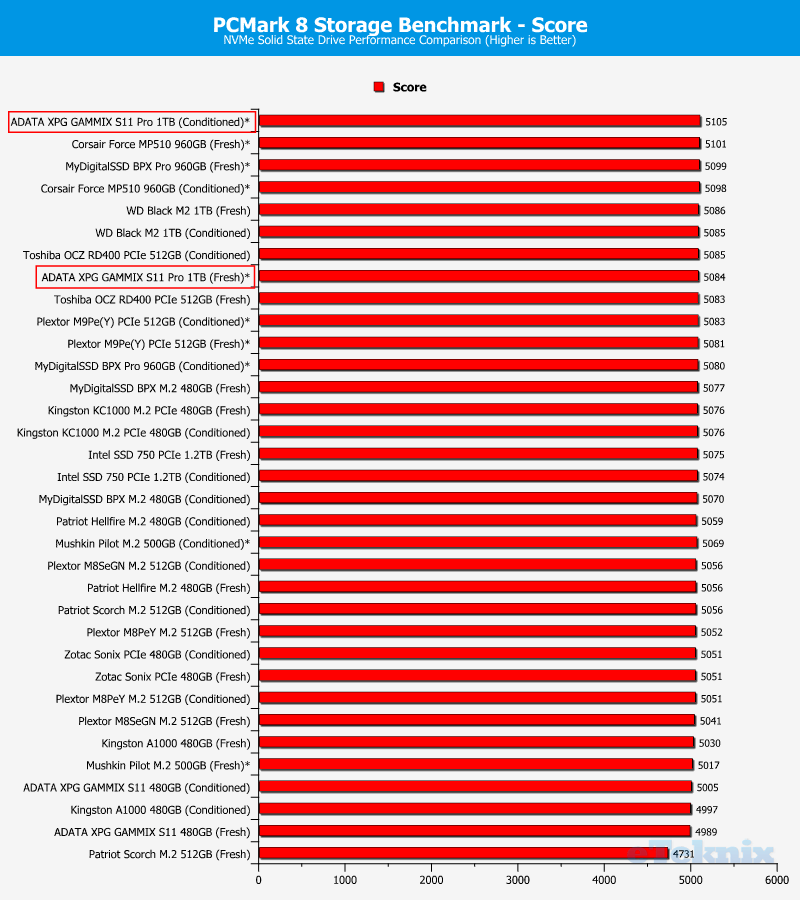
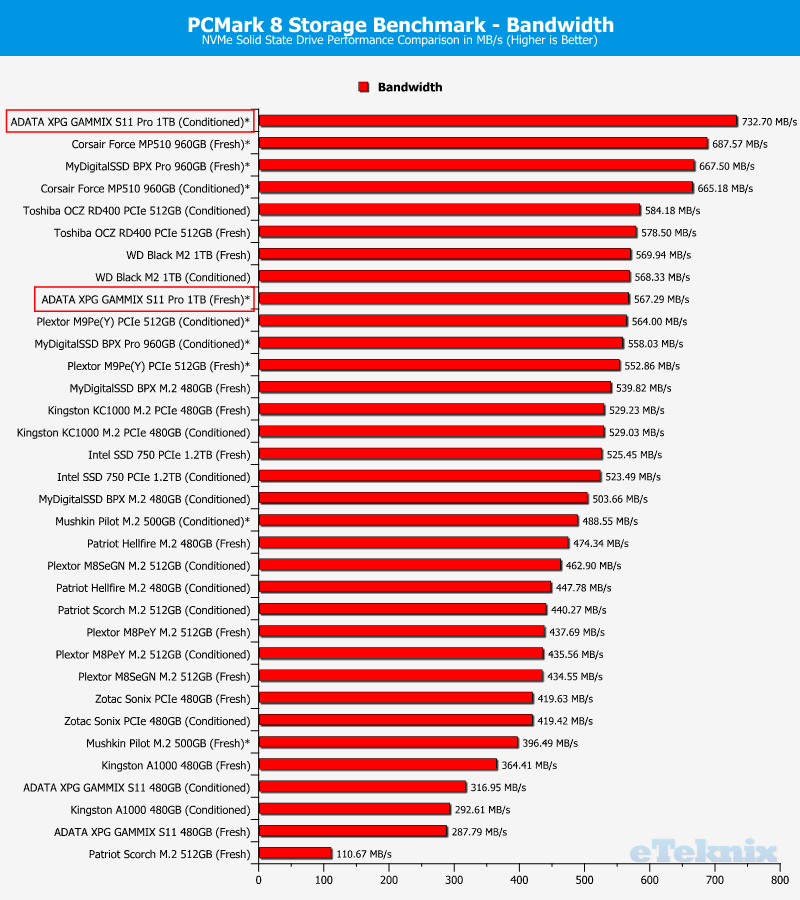
Final Thoughts
Pricing and Availability
At the time of this review, ADATA’s XPG GAMMIX S11 PRO with 1 TB capacity can be yours for £212.80 in the UK. In the US, the 1TB model is currently out of stock. The smaller 512GB is in stock which will cost you as little as $104.99. Those are more than fair prices for such a high-performing drive.
Final Thoughts
I liked the GAMMIX S11, but I love the GAMMIX S11 PRO. ADATA took the feedback they got from the S11 and improved the drive to be able to stand up against the tough competition in this field. We get great performance from the drive which in itself is a beautiful piece of tech.
The XPG GAMMIX S11 Pro is packed with the latest controller which in return provides the best in features. From End-to-End data protection over RAID Engine and LDPC ECC to DevSLP, the drive features it all. ADATA also added a DRAM cache buffer and SLC caching for that extra boost when it matters. All in all, it makes the XPG GAMMIX S11 Pro one of the best NVMe drives available.
Drive Design
The addition of a heatsink to the drive is great. NVMe drives tend to run hot and a heatsink like this can make all the difference. It can be the difference whether the drive suddenly throttles your performance or not. And that can cost you points or even lose a match when it happens at the wrong time.
While a lot of motherboards do come with a heatsink built into the design, it’s still a feature mostly found on the high-end boards. With this drive, you don’t need that. It is born with it.
Pros
- Great performance
- Latest in technology packed together
- Built-in heatsink
- And it’s also Great Looking
- Affordable, even in the 1TB version
Cons
- Can’t use the built-in heatsink as well as motherboard-provided heatsinks. Something to keep in mind.
“ADATA’s XPG GAMMIX S11 Pro is without a doubt one of the best NVMe drives on the market.”
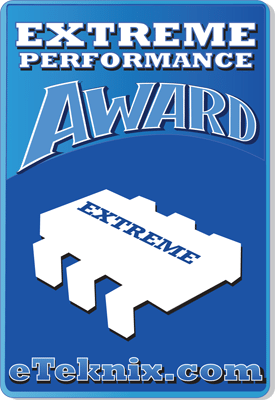
We would like to thank ADATA for this sample.



















